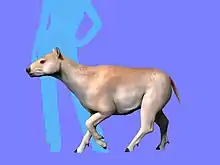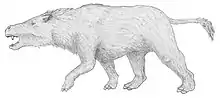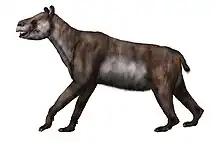Cullinia
Cullinia is an extinct genus of litoptern, an order of South American native ungulates that included horse-like and camel-like animals such as Macrauchenia. It is only known from fragmentary remains. Cullinia levis is known from Chasicoan remains found in the Arroyo Chasicó Formation of Argentina, and remains from the Brazilian state of Acre and the Huayquerian Ituzaingó Formation have been assigned to Cullinia sp. . [1]
| Cullinia | |
|---|---|
 | |
| Right mandibular fragment of Cullinia sp. | |
| Scientific classification | |
| Domain: | Eukaryota |
| Kingdom: | Animalia |
| Phylum: | Chordata |
| Class: | Mammalia |
| Order: | †Litopterna |
| Family: | †Macraucheniidae |
| Subfamily: | †Macraucheniinae |
| Genus: | †Cullinia Cabrera & Kraglievich, 1931 |
| Species: | †C. levis |
| Binomial name | |
| †Cullinia levis Cabrera & Kraglievich, 1931 | |
History and naming
Cullinia was described in 1931 by Cabrera and Kraglievich, from MLP 29-IX-178, an holotype containing several fragmentary remains including a mandible and a metatarsal. In 1995, Bond and López add to the holotype other remains from the upper dentition.[2]
It was named from the Araucanian word "cullin", meaning "animal".[1]
Description
Cullinia was a slender, small Macraucheniidae. It had proportionally larger metapodials than Theosodon, and its first lower molar was absent.[1]
Classification
Below is a phylogenetic tree of the Macraucheniidae, based on the work of McGrath et al. 2018, showing the position of Cullinia.[3]
| |||||||||||||||||||||||||||||||||||||||||||||||||||||||||||||||||||||||||||||||||||||||||||||||||||||||||||||||||||||||||||||||
Palaeoecology
The Arroyo Chasicó formation was, in the Miocene, on the tip of a peninsula bordered by the Paranaense Sea.[4] Cullinia would have lived alongside various genera of Cingulata, including the last horned armadillo Epipeltephilus, the dasypodids Chasicotatus, the chlamyphorid Vetelia, the euphractine Proeuphractus, the pampathere Kraglievichia, and the glyptodont Kelenkura. Other xenarthrans includes several genera of ground sloths, such as the mylodontid Octomylodon, the megalonychid Protomegalonyx, the nothrotheriids Xyophorus and Chasicobradys, and the megatheriid Anisodontherium. Several genera of rodents were recovered from the formation, such as the earliest genera of tuco-tucos, maras and cavioids such as Cardiomys, Procardiomys and Cardiatherium, octodontids such as Chasicomys and Chasichimys, the echimyids Pattersomys, the plain viscacha Lagostomus telenkechanum and its relative Prolagostomus, and the large-sized dinomyid Carlesia. Meridiungulates were also present in the formation, with the fellow litoptern genera such as the fellow macraucheniid Paranauchenia, and the proterotheriid Neobrachytherium, while notoungulates were represented by genera such as the large-sized late surviving homalodotheriid Chasicotherium, the toxodontid Paratrigodon, the interatheriid Protypotherium, the mesotheriid Typotheriopsis, and the hegetotheriids Paedotherium, Pseudohegetotherium and Hemihegetotherium. The largest predators were the sparassodonts Pseudolycopsis cabrerai and Lycopsis viverensis, and the small terror bird Psilopterus.[5][6]
References
- Cabrera, A.; Kraglievich, J. L. (1931). "Diagnosis previas de los ungulados fósiles del arroyo Chasicó". Journal of Mammalian Evolution. 1: 107–113.
- Schmidt, Gabriela I. (2013). Litopterna y Notoungulata (Mammalia) de la formación Ituzaingó (Mioceno tardío-Plioceno) de la provincia de Entre Ríos: sistemática, bioestratigrafía y paleobiogeografía (Thesis). Universidad Nacional de La Plata. doi:10.35537/10915/26442.
- Andrew J. McGrath; Federico Anaya; Darin A. Croft (2018). "Two new macraucheniids (Mammalia: Litopterna) from the late middle Miocene (Laventan South American Land Mammal Age) of Quebrada Honda, Bolivia". Journal of Vertebrate Paleontology. 38 (3): e1461632. doi:10.1080/02724634.2018.1461632. S2CID 89881990.
- Barasoain, D. F.; Zurita, A. E.; Croft, J. D. A.; Montalvo, C. I.; Contreras, V. H.; Miño‑Boilini, A. R.; Tomassini, R. L. (2022). "A New Glyptodont (Xenarthra: Cingulata) from the Late Miocene of Argentina: New Clues About the Oldest Extra‑Patagonian Radiation in Southern South America". Journal of Mammalian Evolution. 29 (2): 263–282. doi:10.1007/s10914-021-09599-w. S2CID 245945029.
- Croft, D. A. (2016). Horned Armadillos and Rafting Monkeys: The Fascinating Fossil Mammals of South America. Indiana University Press. pp. 161–172. ISBN 978-0253020949.
- Fidalgo, F.; Tonni, E. P.; Porro, N.; Laza, J.H. (1987). "Geología del área de la Laguna Chasicó (Partido de Villarino, Provincia de Buenos Aires) y aspectos bioestratigráficos relacionados". Rev Asoc Geol Argentina. 42: 407–416.

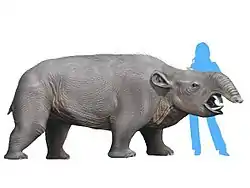
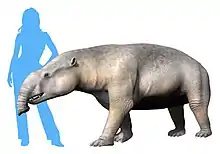
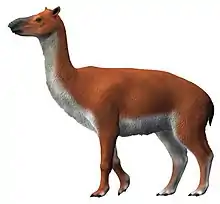
.jpg.webp)
